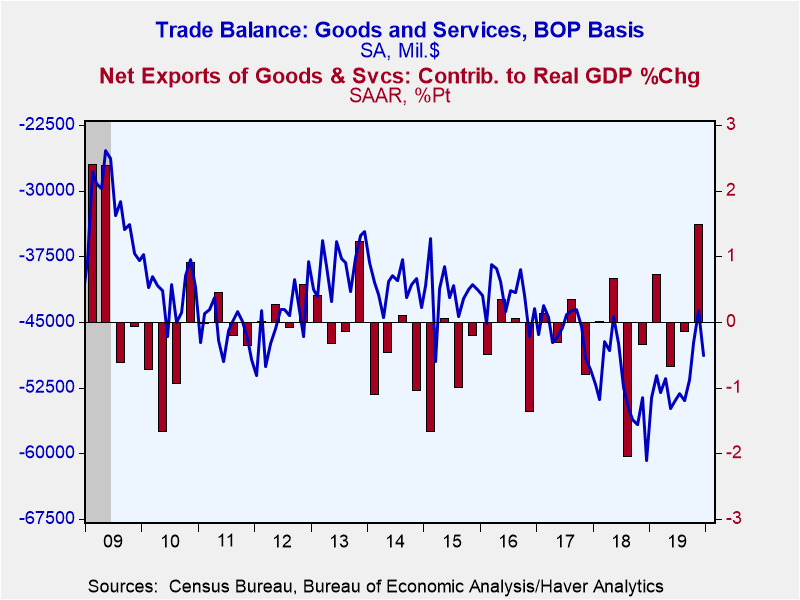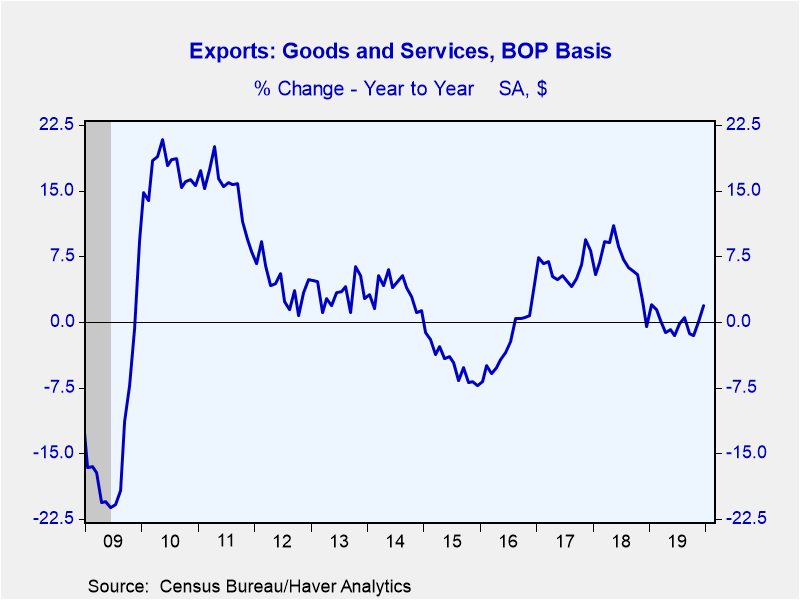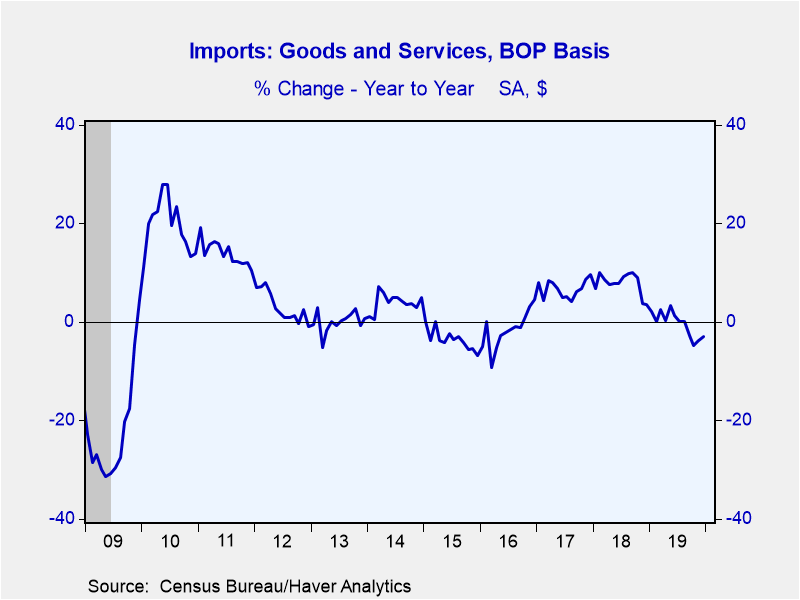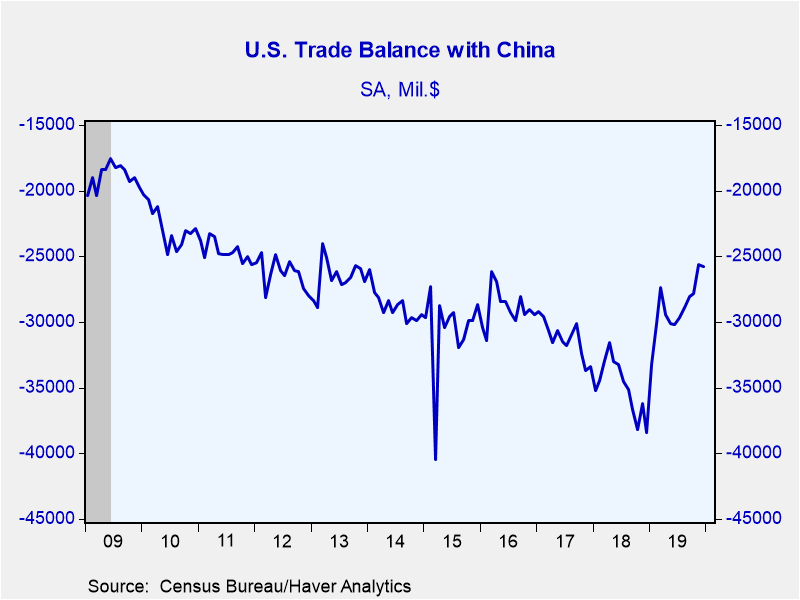 Global| Feb 05 2020
Global| Feb 05 2020U.S. Trade Deficit Widens with Surge in Petroleum Imports
Summary
The U.S. trade deficit in goods and services increased to $48.88 billion in December from $43.69 billion in November, revised from $43.09 billion. A $48.0 billion deficit had been expected in the Action Economics Forecast Survey. [...]
The U.S. trade deficit in goods and services increased to $48.88 billion in December from $43.69 billion in November, revised from $43.09 billion. A $48.0 billion deficit had been expected in the Action Economics Forecast Survey. Exports rose 0.8% (1.9% y/y) after a 0.6% increase in November; imports increased 2.7% (-3.0% y/y) carrying them back up to their October amount.
The trade deficit in goods widened to $69.72 billion in December and the widest deficit since September.
Imports of goods were up 3.2% (-4.6% y/y) including an 18.3% jump in petroleum imports (+6.5% y/y). Nonpetroleum goods imports increased 1.9% (-5.5% y/y). Among the nonpetroleum categories, imports of automotive vehicles, parts and engines fell 1.0% (-6.9% y/y). Other categories all increased: capital goods by 1.2% (-5.9% y/y), food, feed & beverages 1.9% (-2.2% y/y) and nonauto consumer goods 1.3% (-7.0% y/y). "Other" goods imports rose 12.2% (18.6% y/y) and the industrial supplies and materials, which include petroleum, advanced 9.7% (-3.8% y/y). The jump in petroleum imports included a 15.8% increase in the daily volume of crude oil whereas the price of crude actually declined 0.8% (+2.4% y/y).
Exports of goods rose 0.9% (+0.9 y/y), with gains in "other" goods, 18.3% (15.1% y/y), industrial supplies and materials 3.8% (4.6% y/y), food, feed & beverages 0.8% (5.4% y/y) and 0.3% in capital goods (-3.1% y/y). Automotive vehicles & parts exports fell 7.8% (-0.9% y/y) and nonauto consumer goods shipments were down 3.6% (-4.0% y/y).
The surplus on trade in services edged down to $20.8 billion in December from a slightly revised $21.0 billion in November. Services exports rose 0.4% (4.1% y/y). Travel exports rose 1.1% (0.7% y/y). Charges for intellectual property increased 0.2% (4.0% y/y). Imports of services grew 0.8%, the same as in November (4.2% y/y). Travel services imports increased 1.8% (3.9% y/y) and intellectual property imports rose 0.2% (2.7% y/y).
The goods trade deficit with China was steady at $25.7 billion in December after November's $25.6 billion; in December 2018, that deficit was $38.4 billion. Exports to China fell 15.3% (-2.4% y/y), almost exactly reversing their November surge. Imports fell 3.6% (-27.9% y/y), extending a downtrend from a peak in September 2018. The trade deficit with the European Union was $14.0 billion (SA), a slight widening. Exports fell 0.5% (+4.9% y/y) and imports rose 0.7% (+0.1% y/y). The trade deficit with Japan decreased to $4.4 billion (SA) from $5.7 billion in November. Exports rose 16.4% (+1.7% y/y) after November's drop of 9.4%; imports from Japan fell 3.4% (-8.2% y/y).
The international trade data, including relevant data on oil prices, can be found in Haver's USECON database. Detailed figures on international trade are available in the USINT database. The expectations figures are from the Action Economics Forecast Survey, which is carried in AS1REPNA.
| Foreign Trade in Goods & Services (Current $) | Dec | Nov | Oct | Dec Y/Y | 2019 | 2018 | 2017 |
|---|---|---|---|---|---|---|---|
| U.S. Trade Deficit ($ bil.) | 48.88 | 43.69 | 47.37 | 60.81 (12/18) |
616.76 | 627.68 | 550.12 |
| Exports of Goods & Services (% Chg) | 0.8 | 0.6 | -0.1 | 1.9 | -0.1 | 6.3 | 6.2 |
| Imports of Goods & Services (% Chg) | 2.7 | -0.9 | -1.7 | -3.0 | -0.4 | 7.8 | 6.8 |
| Petroleum (% Chg) | 18.3 | -3.2 | 0.0 | 6.5 | -13.9 | 20.8 | 27.2 |
| Nonpetroleum Goods (% Chg) | 1.9 | -1.2 | -2.4 | -5.5 | -0.5 | 7.5 | 5.5 |
Carol Stone, CBE
AuthorMore in Author Profile »Carol Stone, CBE came to Haver Analytics in 2003 following more than 35 years as a financial market economist at major Wall Street financial institutions, most especially Merrill Lynch and Nomura Securities. She has broad experience in analysis and forecasting of flow-of-funds accounts, the federal budget and Federal Reserve operations. At Nomura Securites, among other duties, she developed various indicator forecasting tools and edited a daily global publication produced in London and New York for readers in Tokyo. At Haver Analytics, Carol is a member of the Research Department, aiding database managers with research and documentation efforts, as well as posting commentary on select economic reports. In addition, she conducts Ways-of-the-World, a blog on economic issues for an Episcopal-Church-affiliated website, The Geranium Farm. During her career, Carol served as an officer of the Money Marketeers and the Downtown Economists Club. She has a PhD from NYU's Stern School of Business. She lives in Brooklyn, New York, and has a weekend home on Long Island.









